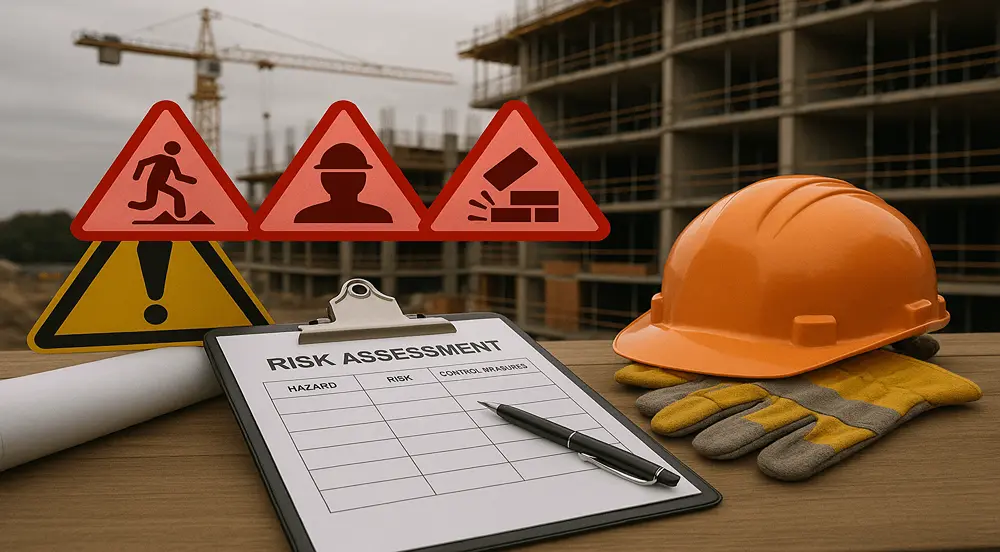Methods like hazard identification, likelihood analysis, and safety audits form the backbone of risk assessment in construction. When neglected, these gaps cause costly delays and injuries. Safe Work Australia notes that poor risk management contributes to nearly 35% of major on-site incidents nationwide.
Site Hazard Identification
Spotting dangers early keeps projects on track and workers safe. Before breaking ground, experts scan for physical threats like unstable soil, chemical risks from materials, and environmental factors such as weather extremes. This proactive step aligns seamlessly with the building construction sequence, preventing disruptions later on.
- Conduct thorough site inspections to map out terrain and existing structures.
- Use standardised checklists to categorise potential hazards systematically.
- Perform geotechnical testing to evaluate soil stability and load-bearing capacity.
Quantitative Risk Analysis
Measuring hazards with data sharpens decision-making in volatile environments. By assigning probability scores and impact values to risks, teams forecast outcomes more reliably. Monte Carlo simulation and sensitivity analysis enhance precision. In construction project management, this approach strengthens budgeting accuracy and minimises scheduling uncertainties.
- Monte Carlo simulation: Generates probabilistic forecasts for cost and schedule variances.
- Sensitivity analysis: Identifies which risks most affect project goals.
- Cost exposure charts: Visualise potential financial impacts across different risk levels.
Statistics show that applying these tools can improve prediction accuracy by up to 20%, helping avoid costly surprises.
Risk Register Development
Centralising threats into one document streamlines oversight and response. A risk register captures every identified issue, from slips on wet surfaces to supply chain delays, alongside their probabilities and assigned owners. This tool fosters accountability in risk assessment in construction, ensuring nothing slips through the cracks.Construction Risk Assessment: What is it and How is it Done?
| Risk Type | Likelihood | Mitigation Strategy |
|---|---|---|
| Structural Collapse | Medium | Reinforce with additional supports and regular inspections |
| Electrical Hazards | High | Install circuit breakers and provide training |
| Weather-Related Delays | Low | Develop contingency schedules and site covers |
Maintaining an updated register, as per international construction management reports, boosts project transparency by 28%, leading to fewer oversights and stronger team collaboration.
Hierarchy of Controls Application
Prioritising smarter safeguards transforms how threats are handled on-site. Starting with elimination, like removing hazardous materials altogether, down to personal protective equipment as a last resort, this framework guides effective risk assessment in construction. As a risk assessment construction company, we apply it to favour durable fixes over temporary ones.
- Elimination: Completely remove the hazard, such as automating high-risk lifting tasks.
- Substitution: Replace dangerous substances, like using low-VOC paints instead of solvent-based ones.
- Engineering controls: Install barriers, for instance, guardrails on elevated platforms.
- Administrative controls: Implement shift rotations to limit exposure to fatigue.
- PPE: Provide helmets and gloves when other measures aren’t feasible.
Australian sites using this hierarchy see 60% fewer falls, proving its power in sustaining safety without relying solely on gear.
BIM-Based Risk Forecasting
Digital twins revolutionise hazard prediction before shovels hit dirt. Building Information Modelling simulates layouts to spot clashes in design, integrating with 4D scheduling for timeline insights. This enhances risk assessment in construction by forecasting issues in the building construction sequence, from foundation to fit-out.
BIM adoption cuts design-phase risk exposure by up to 25%, according to industry benchmarks, allowing teams to refine plans virtually and avoid real-world rework.
Continuous Monitoring and Reporting
Real-time oversight turns static plans into dynamic defences. With IoT sensors tracking vibrations and AI dashboards analysing data trends, projects stay ahead of emerging threats. Drone inspections offer aerial views of hard-to-reach areas, making risk assessment in construction more responsive and precise.
- IoT sensors: Monitor environmental conditions like temperature and humidity continuously.
- AI dashboards: Aggregate data for instant alerts on anomalies.
- Drone inspections: Capture visual evidence of site changes without halting work.
Continuous digital reporting lowers downtime by 18%, as evidenced in recent Australian projects, ensuring swift adjustments and fewer interruptions.
Importance of Effective Risk Management
Strong systems in risk assessment in construction build resilience against uncertainties, fostering client trust and regulatory adherence. Linking this to Construction Project Management, it drives profitability through proactive audits. Projects with such approaches report 22% higher returns, per global studies, by aligning safety with efficiency.
Consequences of Poor Risk Control
Overlooking structured approaches invites chaos, from worker injuries to spiralling delays. In risk assessment in construction, this often results in 35% of cost overruns, draining resources and eroding morale. Higher insurance premiums follow, underscoring the need for robust planning to protect reputations and teams.
Building Safer Projects Through Proactive Risk Culture
Encouraging vigilance across crews sustains momentum and innovation in risk assessment in construction. Leadership must champion accountability, blending disciplines for holistic views. This culture, rooted in transparency and prevention, forms the bedrock of a thriving industry where safety propels productivity forward.


